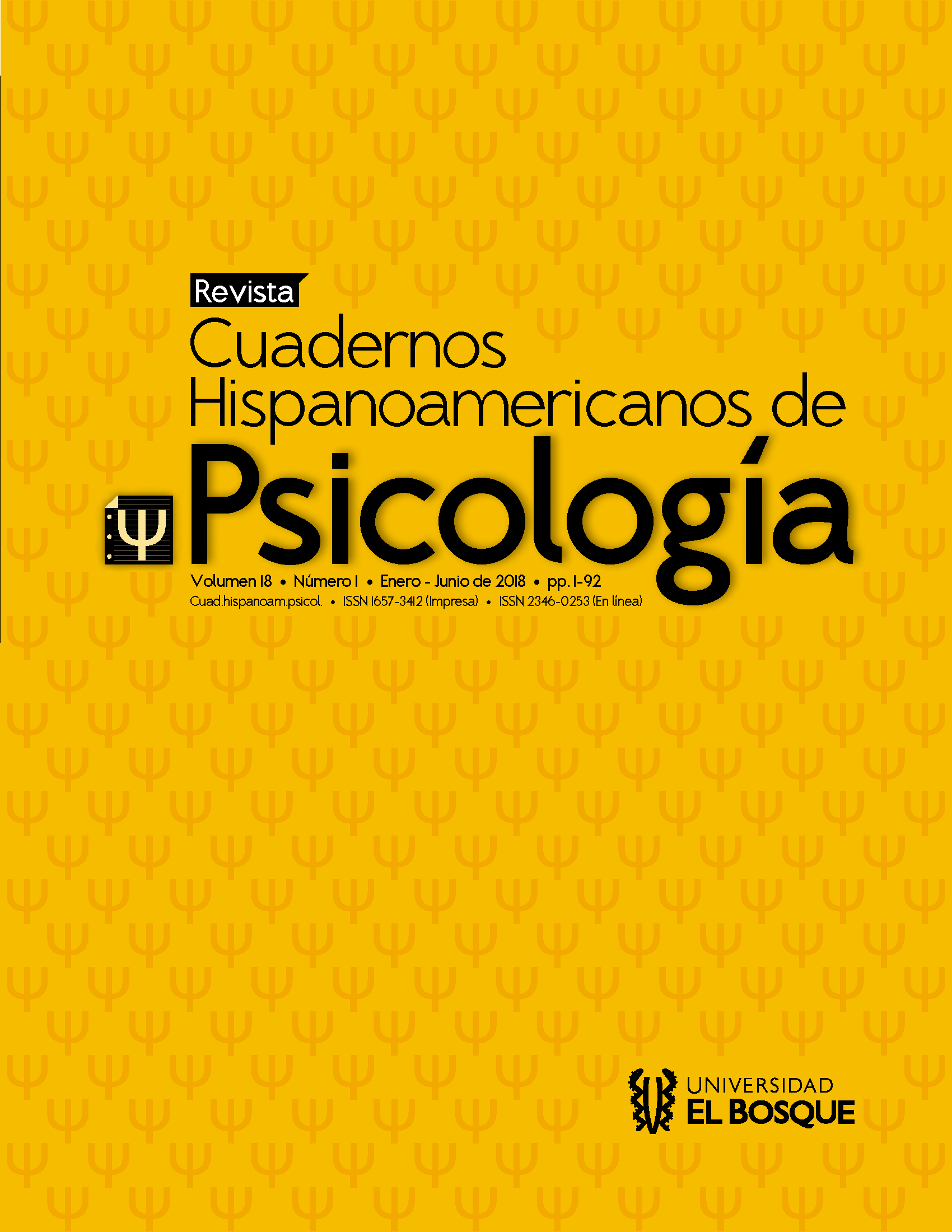Relación entre conductas autolesivas con fines no suicidas y depresión en población adolescente escolarizada
DOI:
https://doi.org/10.18270/chps..v19i2.3149Palabras clave:
depresión, conducta, adolescentes, autolesiones no suicidas, familiaResumen
La depresión es un problema de salud pública, con una prevalencia del 15,8% en niños y adolescentes entre 10 y 14 años; este trastorno está directamente relacionado con conductas autolesivas no suicidas. Diversas investigaciones han demostrado que los síntomas depresivos y las autolesiones aumentan, se estabilizan y disminuyen de manera conjunta en individuos que presentan ambos trastornos. El objetivo de la presente investigación fue establecer la relación existente entre las conductas autolesivas con fines no suicidas y la depresión en adolescentes escolarizados de la ciudad de Pereira, Colombia. Se realizó un muestreo no probabilístico por conveniencia. Se evaluaron 44 adolescentes de los grados sexto, séptimo y octavo de la Institución. Educativa Santa Rosa de Lima mediante los cuestionarios CDI, SHQ-E y una encuesta sociodemográfica. Los datos se analizaron con el programa SPSS v.22, y el Coeficiente de Pearson, tanto para el nivel descriptivo, como correlacional. Los resultados muestran correlaciones altas y positivas entre depresión infantil y conductas autolesivas. Se concluye que existe una relación significativa entre sintomatología depresiva y conductas autolesivas.
Descargas
Referencias bibliográficas
Albarracín, L., & González, L. (2019). Vínculos afectivos familiares en mujeres adolescentes con conductas autolesivas no suicidas. Cuadernos Hispanoamericanos de Psicología, 19(1), 1-18. https://doi. org/10.18270/chps..v19i1.2977
Albores, L., Méndez, J., García, L., Delgadillo, Chávez, C., Y., Martínez, O. (2014). Autolesiones sin intención suicida en una muestra de niños y adolescentes de la ciudad de México. Actas Españolas de Psiquiatría, 42(4), 159-168. https://www.actaspsiquiatria.es/repositorio/16/90/ESP/16-90ESP-159-168-346514.pdf
Ammerman, B., Jacobucci, R., Kleiman, E., Uyeji, L., & McCloskey, M. (2017). The relationship between non-suicidal self-injury age of onset and severity of self-harm. Suicide and Life-Threatening Behavior, 48(1), 31-37. https://onlinelibrary.wiley.com/doi/full/10.1111/sltb.12330
Andover, M., & Morris, B. (2014). Expanding and clarifying the role of emotion regulation in non-suicidal self-injury. The Canadian Journal of Psychiatry, 59(11), 569-575. http://dx.doi. org/10.1177/070674371405901102
Andover, M. S., Morris, B., Wren, A., & Bruzzese, M. (2012). The co-occurrence of non-suicidal self-injury and attempted suicide among adolescents: distinguishing risk factors and psychosocial correlates. Child and Adolescent Psychiatry and Mental Health, 6(11), 1-7. http://dx.doi.org/10.1186/17532000-6-11
Asarnow, J., Porta, G., Spirito, A., Emslie, G., Clarke, G., Wagner, K. & Brent, D. (2011). Suicide Attempts and Non-suicidal Self-Injury in the Treatment of Resistant Depression in Adolescents: Findings from the TORDIA Study. Journal of the American Academy of Child y Adolescent Psychiatry, 50(8), 772–http://dx.doi.org/10.1016/j.jaac.2011.04.003
Babore, A., Trumello, C., Candelori, C., Paciello, M., & Cerniglia, L. (2016). Depressive symptoms, self-esteem and perceived parent – child relationship in early adolescence.
Frontiers Psychology, 7, 982. http://dx.doi.org/10.3389/fpsyg.2016.00982 Baetens, I., Claes, L., Muehlenkamp, J., Grietens, H., & Onghena, P. (2011). Non-suicidal and suicidal self-injurious behavior among Flemish adolescents: A web-survey. Archives of Suicide Research, 15(1), 5667. http://dx.doi.org/10.1080/13811118.2011.540467
Báez, M., Vera, Z., Mendoza, M., & González, C. (2019). Relación entre miedo, trastornos de ansiedad y depresión en escolares en una escuela subvencionada de Asunción. Revista Científica Estudios e Investigaciones, 8, 241-242. https://doi.org/10.26885/rcei.foro.2019.241
Barrocas, A., Giletta, M., Hankin, B., Prinstein, M., & Abela, J. (2015). Non-suicidal self-injury in adolescence: Longitudinal course, trajectories, and intrapersonal predictors. Journal of Abnormal Child Psychology, 43(2), 369-380. http://dx.doi.org/10.1007/s10802-014-9895-4
Beck, A.; Rush, A.; Shaw, B. & Emery, G., (2003). Terapia cognitiva de la depresión. España: Editorial Desclée de Brouwer, S.A. Beck, J. (2008). Terapia Cognitiva. Conceptos básicos y profundización. Colección Terapia Familiar. Argentina: Gedisa Editorial.
Beltrán, M., Freyre, M., & Hernández, L. (2012). El Inventario de Depresión de Beck: Su validez en población adolescente. Terapia Psicológica, 30(1), 5-13. http://dx.doi.org/10.4067/S0718-48082012000100001
Benito, C. & Ventura, J. (2016). Indicadores de depresión en niños de cuarto a sexto grado de primaria en la ciudad de Huancayo. Horizonte de la Ciencia, 6(10), 195-203. http://revistas.uncp.edu.pe/index. php/horizontedelaciencia/article/view/369
Bernaras, E., Jaureguizar, J. & Garaigordobil, M. (2019) Child and Adolescent Depression: A Review of Theories, Evaluation Instruments, Prevention Programs, and Treatments. Front. Psychol. 10, 543. http:// dx.doi.org/10.3389/fpsyg.2019.00543
Bernaras, E., Garaigordobil, M., Jaureguizar, J., & Soroa, M. (2018). Mild and severe childhood depression: differences and implications for prevention programs in the school setting. Psychology research and behavior management, 11, 581–588. https://doi.org/10.2147/PRBM.S184014
Bousoño, M., Al-Halabí, S., Burón, P., Garrido, M., Díaz, E., Galván, G., García, L., Velasco, Á., Rodríguez, J., Wasserman, C., Carli, V., Hoven, C., Sarchiapone, M., Wasserman, D., Bousoño, M., García, M., Iglesias, C., Sáiz, P., & Bobes, J. (2019). Consumo de alcohol y factores de riesgo de conductas autolesivas en adolescentes españoles. Adicciones http://dx.doi.org/10.20882/adicciones.1239
Brausch, A., & Gutierrez, P. (2010). Differences in non-suicidal self-injury and suicide attempts in adolescents. Journal of youth and adolescence, 39(3), 233-242. http://dx.doi.org/10.1007/s10964-009-9482-0
Brausch, A. & Muehlenkamp, J. (2018). Perceived effectiveness of NSSI in achieving functions on severity and suicide risk. Psychiatry research, 265, 144-150. https://doi.org/10.1016/j.psychres.2018.04.038
Bresin, K., & Schoenleber, M. (2015). Gender differences in the prevalence of non-suicidal self-injury: A meta-analysis. Clinical Psychology Review, 38, 55–64. http://dx.doi.org/10.1016/j.cpr.2015.02.009
Briere, J., & Gil, E. (1998). Self-mutilation in clinical and general population samples: Prevalence, correlates, and functions. American journal of Orthopsychiatry, 68(4), 609-620. https://doi.org/10.1037/ h0080369
Brown, M., Comtois, K., & Linehan, M. (2002). Reasons for suicide attempts and non-suicidal self-injury in women with borderline personality disorder. Journal of Abnormal Psychology, 111(1), 198–202. https://doi.org/10.1037/0021-843X.111.1.198
Bueno, D. (2019). Funcionalidad familiar y ansiedad en adolescentes de una institución educativa nacional. http://repositorio.unfv.edu.pe/handle/UNFV/3833
Buelens, T., Luyckx, K., Kiekens, G., Gandhi, A., Muehlenkamp, J., & Claes, L. (2019). Investigating the DSM-5 criteria for Non-Suicidal Self-Injury Disorder in a community sample of adolescents. Journal of Affective Disorders. http://dx.doi.org/10.1016/j.jad.2019.09.009
Burke, T., Piccirillo, M., Moore-Berg, S., Alloy, L., & Heimberg, R. (2018). The stigmatization of non-suicidal self-injury. Journal of Clinical Psychology. 75(3), 329-343. http://dx.doi.org/10.1002/jclp.22713
Calvete, E., Orue, I., Aizpuru, L., & Brotherton, H. (2015). Prevalence and functions of non-suicidal self-injury in Spanish adolescents. Psicothema, 27(3), 223-228. http://dx.doi.org/10.7334/psicothema2014.262
Carrasco, M., Del Barrio, M., & Rodríguez, J. (2000). Sintomatología depresiva en escolares de 12 a 16 años y su relación con las distorsiones cognitivas. Revista de psicopatología y psicología clínica, 5(1), 4570. http://e-spacio.uned.es/fez/eserv.php?pid=bibliuned:Psicopat-2000-3C5A4533-B2D5-93B1-69DC -811D493A7B05ydsID=PDF
Casillas, D. (2020). La autolesión como forma de expresión de las emociones. El papel que juega la retroflexión en las autolesiones. Revista de la Universidad del Valle de Atemajac, 96, 30-37. https://www. univa.mx/publicaciones/revistas/2020/No-96-enero.pdf#page=32
Ceballos, G., Suarez, Y., Suescún, J., Gamarra, L., González, K. & Sotelo, A. (2015). Ideación suicida, depresión y autoestima en adolescentes escolares de Santa Marta. Duazary, 12(1), 15 - 22. https://doi. org/10.21676/2389783X.1394
Claes, L., & Muehlenkamp, J. (2014). Non-suicidal self-injury in eating disorders. Heidelberg/New York: Springer. http://dx.doi.org/10.1007/978-3-642-40107-7
Colman, I., Zeng, Y., McMartin, S., Naicker, K., Ataullahjan, A., Weeks, M., Senthilselvan, A., & Galambos, N. (2014). Protective factors against depression during the transition from adolescence to adulthood: findings from a national Canadian cohort. Prev. Med. 65, 28–32. http://dx.doi.org/10.1016/j. ypmed.2014.04.008
Daukantaitė, D., Lantto, R., Liljedahl, S. I., Helleman, M., & Westling, S. (2020). One-Year Consistency in Lifetime Frequency Estimates and Functions of Non-Suicidal Self-Injury in a Clinical Sample. Frontiers in Psychiatry, 11, 1-9. https://doi.org/10.3389/fpsyt.2020.00538
Del Barrio, V. (2000). La Depresión Infantil. Factores de Riesgo y Posibles Soluciones. Málaga: Aljibe.Del Barrio, V., & Carrasco, M. (2013). Depresión en Niños y Adolescentes. Madrid: Síntesis.
Del Barrio, V. (2013). La depresión infantil a la altura de nuestro tiempo. Información Psicológica, (100), 4959. https://dialnet.unirioja.es/servlet/articulo?codigo=3642738
Del Barrio, V., Mestre, M., Tur, A. & Samper, P. (2004). La depresión infanto-juvenil: el efecto de los factores emocionales, comportamentales y sociodemográficos. Revista de psicología general y aplicada: Revista de la Federación Española de Asociaciones de Psicología, 57(1), 5-20. https://dialnet.unirioja.es/ servlet/articulo?codigo=856425
Del Barrio, V. (2015). Los trastornos depresivos y sus tratamientos. En R. González e I. Montoya-Castilla (Eds.), Psicología clínica infantojuvenil (pp. 295-326). Madrid: Pirámide.
Díaz, C. & Santos, L. (2018). La ansiedad en la adolescencia. RqR Enfermería Comunitaria, 6 (1), 21-31. https://dialnet.unirioja.es/servlet/articulo?codigo=6317303
Díaz, J. & Díaz, M. (2015). Depresión en la adolescencia. Revisión. Revista de Psiquiatría y Psicología del Niño y del Adolescente, 11(1-2), 12-52. http://www.psiquiatriainfantil.org/2015/2015(1-2).pdf
Favazza, A. (2012). Non-suicidal self-injury: How categorization guides treatment. Current Psychiatry, 11 (3), 21-25. https://www.researchgate.net/publication/267561838
Ferreira S., Martins, C., Rosendo, A., Machado, B., & Silva, E. (2012). Self-injurious behavior in Portuguese adolescents. Psicothema, 24(4), 536-541. Disponible en: https://www.redalyc.org/ pdf/727/72723959005.pdf
Fleta, J. (2017). Autolesiones en la adolescencia: una conducta emergente. Boletín de la sociedad de pediatría de Aragón, La Rioja y Soria, (2), 37-45. https://dialnet.unirioja.es/servlet/articulo?codigo=6393711
Flores, M., Cancino, M., & Figueroa, M. (2018). Revisión sistemática sobre conductas autolesivas sin intención suicida en adolescentes. Rev Cubana Salud Pública, 44(4), 200-216. https://www.scielosp. org/pdf/rcsp/2018.v44n4/200-216/es
Fontenot, L., Jackson, J., & Terry, D. (2015). Depressive and Anxious Symptomatology Moderate the Relationship Between Childhood Emotional Abuse Severity and Attentional Bias on the Modified Stroop Task. Journal of Aggression, Maltreatment y Trauma, 24(7), 753–772. https://doi.org/10.1080/1092 6771.2015.1062446
Ford, J., & Gómez, J. (2015). The relationship of psychological trauma and dissociative and posttraumatic stress disorders to non-suicidal self-injury and suicidality: A review. Journal of Trauma y Dissociation, 16(3), 232-271. http://dx.doi.org/10.1080/15299732.2015.989563
Fox, K., Franklin, J., Ribeiro, J., Kleiman, E., Bentley, K., & Nock, M. K. (2015). Meta-analysis of risk factors for non-suicidal self-injury. Clinical psychology review, 42, 156-167. http://dx.doi.org/10.1016/j.cpr.2015.09.002
Frías, A., Vázquez, M., Del Real, A., Sánchez, C., & Giné, E. (2012). Conducta autolesiva en adolescentes: prevalencia, factores de riesgo y tratamiento. Cuadernos de medicina psicosomática y psiquiatría de enlace, 103, 33-48. http://dialnet.unirioja.es/servlet/articulo?codigo=4393274
Gandhi, A., Luyckx, K., Baetens, I., Kiekens, G., Sleuwaegen, E., Berens, A., Maitra, S., & Claes, L. (2018). Age of onset of NSSI in Dutch-speaking adolescents and emerging adults: An event history analysis of pooled data. Comprehensive Psychiatry, 80, 170-178. http://dx.doi.org/10.1016/j.comppsych.2017.10.007
Garaigordobil, M., Bernarás, E., Jaureguizar, J. & Machimbarrena, J. (2017) Childhood Depression: Relation to Adaptive, Clinical and Predictor Variables. Front. Psychol, 8, 821. http://dx.doi.org/10.3389/ fpsyg.2017.00821
Garaigordobil, M., Jaureguizar, J., & Bernarás, E. (2019). Evaluation of the effects of a childhood depression prevention program. The Journal of psychology, 153(2), 127-140. https://doi.org/10.1080/00223980 .2018.1502741
García, J., De Jesús, A., Mayorga, S., Guerrero, L., & Ramírez, J. (2015). Validación al español del Self-Harm Questionnaire para detección de autolesión en adolescentes. Salud mental, 38(4), 287-292. https:// www.redalyc.org/pdf/582/58241191008.pdf
Glenn, C., & Klonsky E. (2010). A Multimethod Analysis of impulsivity in Non-suicidal Self-Injury. Personality Disorders: Theory, Research, and Treatment, 1(1), 67-75. http://dx.doi.org/10.1037/a0017427
González, L., Vasco, I., & Nieto, L. (2016). Revisión de la literatura sobre el papel del afrontamiento en las autolesiones no suicidas en adolescentes. Cuadernos Hispanoamericanos de Psicología, 16(1), 41-56. http://dx.doi.org/10.18270/chps..v16i1.1968
Granados, B., Orts, C. & Rey, L. (2020). Regulación emocional y uso problemático de las redes sociales en adolescentes: el papel de la sintomatología depresiva. Health and Addictions, 20 (1), 77-86. https:// www.researchgate.net/publication/339843166
Grube, M. (2004). Which types of aggressive behaviour are associated with suicidal and self-injurious behaviour at the time of admission? Psychopathology, 37(1), 41-49. http://dx.doi.org/10.1159/000077019
Hamza, C., Stewart, S., & Willoughby, T. (2012). Examining the link between non-suicidal self-injury and suicidal behavior: A review of the literature and an integrated model. Clinical Psychology Review, 32(2012), 482-495. http://dx.doi.org/10.1016/j.cpr.2012.05.003
Hamza, C. & Willoughby, T. (2019). Impulsivity and non-suicidal self-injury: A longitudinal examination among emerging adults. Journal of Adolescence, 75, 37-46. https://doi.org/10.1016/j.adolescence.2019.07.003
Hamza, C., Willoughby, T., & Armiento, J. (2014). A laboratory examination of pain threshold and tolerance among non-suicidal self-injurers with and without self-punishing motivations. Archives of Scientific Psychology, 2(1), 33. http://dx.doi.org/10.1037/arc0000008
Hawton, K., Saunders, K., & O’Connor, R. (2012). Self-harm and suicide in adolescents. The Lancet, 379(9834), 2373-2382. http://dx.doi.org/10.1016/S0140-6736(12)60322-5
Hernández, J., Joanico, B., Juanico, G., Salgado, M. & Zaragoza, I. (2020). Depresión y factores asociados en niños y adolescentes de 7 a 14 años de edad. Atención Familiar, 27(1), 38-42. http://dx.doi. org/10.22201/facmed.14058871p.2020.1.72281
Huamaní, L. (2020). Impulsividad y autolesión en adolescentes de dos instituciones educativas públicas del distrito de Carmen de la Legua Reynoso - Callao. http://repositorio.ucv.edu.pe/handle/20.500.12692/43161
International Society for the Study of Self-injury. (2018). What is self-injury? https://itriples.org/about-self-injury/what-is-self-injury
Jaureguizar, J., Bernaras, E., & Garaigordobil, M. (2017). Child depression: prevalence and comparison between self-reports and teacher reports. Spanish Journal Psychology, 20, 17. http://dx.doi.org/10.1017/ sjp.2017.14
Jaureguizar, J., Garaigordobil, M. & Bernaras, E. (2018). Self-concept, Social Skills, and Resilience as Moderators of the Relationship Between Stress and Childhood Depression. School Mental Health ,10, 488–499. https://doi.org/10.1007/s12310-018-9268-1
Jacobson, C., Muehlenkamp, J., Miller, A., & Turner, J. (2008). Psychiatric impairment among adolescents engaging in different types of deliberate self-harm. Journal of Clinical Child y Adolescent Psychology, 37(2), 363-375. http://dx.doi.org/10.1080/15374410801955771
Jones, M. (2019). A Meta-analysis of the Effectiveness of Behavioral Intervention Technologies and Faceto-face Cognitive Behavioral Therapy for Youth with Depression. https://search.proquest.com/openview/476687f7eb3e87c83e410b47d48596be/1?pq-origsite=gscholarycbl=51922ydiss=y
Keles, S., & Idsoe, T. (2018). A meta-analysis of group Cognitive Behavioral Therapy (CBT) interventions for adolescents with depression. Journal of Adolescence, 67, 129–139. https://doi.org/10.1016/j.adolescence.2018.05.011
Kiekens, G., Hasking, P., Boyes, M., Claes, L., Mortier, P., Auerbach, R.P., Cuijpers, P., Demyttenaere, K., Green, J.G., Kessler, R.C., Myin-Germeys, L., Nock, M.N, & Bruffaerts, R. (2018). The associations betweennon-suicidal self-injury and first onset suicidal thoughts and behaviors. Journal of Affective Disorders, 239, 171-179. http://dx.doi.org/10.1016/j.jad.2018.06.033
Klonsky, E., Victor, S., & Saffer, B. (2014). Non-suicidal self-injury: What we know, and what we need to know. http://dx.doi.org/10.1177/070674371405901101
Lagos, M., Ossa, C., Palma, M. & Arriagada, C. (2020). Self-perception of emotional development of secondary students in the Ñuble region, Chile. Revista de estudios y experiencias en educación, 19(39), 17-27. https://dx.doi.org/10.21703/rexe.20201939lagos1
Lazarus, R.S., & Folkman, S. (1986). Estrés y procesos cognitivos (2da ed). Barcelona, España: Martínez Roca.
Lin, M., You, J., Ren, Y., Wu, J., Hu, W., Yen, C., & Zhang, X. (2017). Prevalence of non-suicidal self-injury and its risk and protective factors among adolescents in Taiwan. Psychiatry Research, 255, 119-127. http://dx.doi.org/10.1016/j.psychres.2017.05.028
Linehan, M. M. (1993). Diagnosis and treatment of mental disorders.Cognitive-behavioral treatment of borderline personality disorder. https://psycnet.apa.org/record/1993-97864-000
Liu, S., You, J., Ying, J., Li, X., & Shi, Q. (2020). Emotion reactivity, non-suicidal self-injury, and regulatory emotional self-efficacy: a moderated mediation model of suicide ideation. Journal of affective disorders, 266, 82-89. https://doi.org/10.1016/j.jad.2020.01.083
Lloyd-Richardson, E., Perrine, N., Dierker, L., & Kelley, M. (2007). Characteristics and functions of non-suicidal self-injury in a community sample of adolescents. Psychological Medicine, 37 (8), 1183–1192. http://dx.doi.org/10.1017/S003329170700027X
Lynch, T., & Cozza, C. (2009). Behavior therapy for nonsuicidal self-injury. En M. K. Nock (Ed.), Understanding non-suicidal self-injury: Origins, assessment, and treatment (p. 211–250). American Psychological Association. https://doi.org/10.1037/11875-012
Manca, M., Presaghi, F., & Cerutti, R. (2013). Clinical specificity of acute versus chronic self-injury: Measurement and evaluation of repetitive non-suicidal self-injury. Psychiatry Research, 215, 111-119. https:// doi.org/10.1016/j.psychres.2013.10.010
Martínez, A., & Izzedin, R. (2007). Tristeza, depresión y estrategias de autorregulación en niños. Tesis Psicológica, 2(1), 35-47.
Martínez, A., & Rosselló, J. (2016). Depresión y funcionamiento familiar en niños/as y adolescentes puertorriqueños/as. Revista Puertorriqueña de Psicología, 10(1), 215-245. http://www.ojs.repsasppr.net/ index.php/reps/article/view/94
Mayer, P., Morales, N., Figueroa, V., & Ulloa, R. (2016). Adolescentes con autolesiones e ideación suicida: un grupo con mayor comorbilidad y adversidad psicosocial. Salud pública de México, 58, 335-336. https://doi.org/10.21149/spm.v58i3.7893
Méndez, F., Olivares, J. & Ros, M. (2001). Estado de ánimo depresivo: Características clínicas y tratamiento de la depresión en la infancia y adolescencia. En V. E., Caballo & M. A. Simon, Manual de psicología clínica infantil y del adolescente: Trastornos generales. Pirámide.
Ministerio de Salud. (2018). Boletín de salud mental en niños, niñas y adolescentes 2018. https://www.minsalud.gov.co/sites/rid/Lists/BibliotecaDigital/RIDE/VS/PP/ENT/boletin-4-salud-mental-nna-2017.pdf
Ministerio de Salud. (2015). Encuesta Nacional de Salud Mental 2015. http://www.odc.gov.co/Portals/1/ publicaciones/pdf/consumo/estudios/nacionales/CO031102015-salud_mental_tomoI.pdf
Ministerio de Salud. (1993). Resolución número 8430 de 1993. https://www.minsalud.gov.co/sites/rid/Lists/ BibliotecaDigital/RIDE/DE/DIJ/RESOLUCION-8430-DE-1993.PDF
Molina, R., & Arranz, J. (2010). Depresión. https://www.miguelflorencio.com/books/Psicologia/depresion. pdf
Mollà, L., Batlle, S., Treen, D., López, J., Sanz, N., Martín, L., Pérez, V., & Bulbena, A. (2015). Autolesiones no suicidas en adolescentes: revisión de los tratamientos psicológicos. Revista de Psicopatología y Psicología Clínica, 1(1). https://doi.org/10.5944/rppc.vol.1.num.1.2015.14408
Moreno, C., & Araque, Y. (2016). Estudio descriptivo correlacional: ideación suicida emociones negativas, autoestima, satisfacción vital en adolescentes localidad Kennedy. https://hdl.handle.net/11634/3336
Muehlenkamp, J., Brausch, A., Quigley, K., & Whitlock, J. (2013). Interpersonal features and functions of non-suicidal self-injury. Suicide and Life-Threatening Behavior, 43(1), 67-80. https://doi.org/10.1111/ j.1943-278X.2012.00128.x
Muehlenkamp, J., Claes, L., Havertape, L., & Plener, P. (2012). International prevalence of adolescent non-suicidal self-injury and deliberate self-harm. Child and adolescent psychiatry and mental health, 6(10), 1-9. https://capmh.biomedcentral.com/articles/10.1186/1753-2000-6-10
Nock, M. (2010). Self-injury. Annual review of clinical psychology, 6, 339-363. https://doi.org/10.1146/annurev.clinpsy.121208.131258
Nock, M., Joiner, T., Gordon, K., Lloyd-Richardson, E., & Prinstein, M. (2006). Non-suicidal self-injury among adolescents: diagnostic correlates and relation to suicide attempts. Psychiatry Research, 144, 65–72. https://doi.org/10.1016/j.psychres.2006.05.010
Nock M., & Prinstein M. (2004). A functional approach to the assessment of self-mutilative behavior. Journal of Consulting and Clinical Psychology, 72, 885-90. https://doi.org/10.1037/0022-006X.72.5.885
Nowicki, S., Gregory, S., Iles-Caven, Y., Ellis, G. & Golding, J. (2018). Early Home-Life Antecedents of Children’s Locus of Control. Frontiers in Psychology. 9, 2032. https://doi.org/10.3389/fpsyg.2018.02032
Obando, D., Trujillo, Á., & Prada, M. (2019). Conducta autolesiva no suicida en adolescentes y su relación con factores personales y contextuales. Revista de Psicopatología y Psicología Clínica, 23(3), 189. https://doi.org/10.5944/rppc.vol.23.num.3.2018.21278
Observatori de Bioética i Dret (1979). Informe de Belmont. Principios y guías éticos para la protección de los sujetos humanos de investigación. http://www.bioeticayderecho.ub.edu/archivos/norm/InformeBelmont.pdf
Oliva, A., Antolín, L., & Rodríguez, A. (2019). Uncovering the link between self-control, age, and psychological maladjustment among Spanish adolescents and young adults. Psychosocial Intervention, 28(1), 49-55. https://doi.org/10.5093/pi2019a1
Organización Mundial de la Salud (2018). Salud Mental del Adolescente. https://www.who.int/es/newsroom/fact-sheets/detail/adolescent-mental-health
Organización Panamericana de la Salud (2018). La carga de los trastornos mentales en la Región de las Américas. https://www.saldarriagaconcha.org/wp-content/uploads/2019/01/La-carga-de-los-trastornos-mentales-en-la-Regi%C3%B3n-de-las-Am%C3%A9ricas-2018.pdf
Ospina, M., Ulloa, M., & Ruiz, L. (2019). Autolesiones no suicidas en adolescentes: prevención y detección en la atención primaria. Medicina de Familia. Semergen, 45(8), 546-551. https://doi.org/10.1016/j. semerg.2019.02.010
Paul, E., Tsypes, A., Eidlitz, L., Ernhout, C., & Whitlock, J. (2015). Frequency and functions of non-suicidal self-injury: Associations with suicidal thoughts and behaviors. Psychiatry research, 225(3), 276-282. https://doi.org/10.1016/j.psychres.2014.12.026
Orgilés, M., Samper, M., Fernández, I., & Espada, J. (2018). Depresión en preadolescentes españoles: Diferencias en función de variables familiares. http://riberdis.cedd.net/bitstream/handle/11181/5338/ Depresi%c3%b3n_en_preadolescentes_espa%c3%b1oles.pdf?sequence=1yrd=003186207787361
Peña, E., Mejía, K., Ruíz, A., Monsiváis, R. & Álvarez, C. (2019). Scale of cognitive symptoms in depression (EsADFUN). Arch Neurocien, 24(4), 14-22. https://www.medigraphic.com/cgi-bin/new/resumenI. cgi?IDARTICULO=91557yidP=8710
Plener, P., Schumacher, T., Munz, L., & Groschwitz, R. (2015). The longitudinal course of non-suicidal self-injury and deliberate self-harm: a systematic review of the literature. Borderline personality disorder and emotion dysregulation, 2(1), 2. https://doi.org/10.1186/s40479-014-0024-3
Qualter, P., Brown, S., Munn, P., & Rotenberg, K. (2010). Childhood loneliness as a predictor of adolescent depressive symptoms: an 8-year longitudinal study. Eur. Child Adolesc. Psychiatry 19, 493–501. https://doi.org/10.1007/s00787-009-0059-y
Quant, D., Toro, R., Pineda, L., Robayo, H., & Hernández, Y. (2016). Validación preliminar de una guía de evaluación e intervención transdiagnóstica en depresión infantil. Revista Evaluación e Intervención Psicológica, 1(2), 111-121. http://190.65.221.162:1094/Revistas/index.php/UNINCCA/article/view/15
Ramírez, R. (2009). Adaptación del inventario de depresión infantil de Kovacs en escolares de la ciudad de Cajamarca [Tesis de pregrado, Pontificia Universidad Católica] http://tesis.pucp.edu.pe/repositorio/ bitstream/handle/20.500.12404/409/RAMIREZ_BARRANTES_RENATO_ADAPTACION_INVENTARIO_ DEPRESION.pdf?sequence=1yisAllowed=y
Reinfjell, T., Kårstad, S., Berg-Nielsen, T., Luby, J., & Wichstrøm, L. (2016). Predictors of change in depressive symptoms from preschool to first grade. Development and Psychopathology, 28, 1517–1530. https:// doi.org/10.1017/S0954579415001170
Rehm, L. P. (1977). A self-control model of depression. Behavior Therapy, 8(5), 787–804. https://doi. org/10.1016/s0005-7894(77)80150-0
Ren, Y., Lin, M., Liu, Y., Zhang, X., Wu, J., Hu, W., Xu, S., & You, J. (2018). The mediating role of coping strategy in the association between family functioning and non-suicidal self-injury among Taiwanese adolescents. Journal of clinical psychology, 74(7), 1246-1257. https://doi.org/10.1002/jclp.22587
Rey, J., Bella-Awusah, T., & Liu, J. (2017). Depresión en niños y adolescentes. https://iacapap.org/content/ uploads/E.1-Depresi%C3%B3n-Spanish-2017.pdf
Ribeiro, J., Franklin, J., Fox, K., Bentley, K., Kleiman, E., Chang, B., & Nock, M. (2016). Self-injurious thoughts and behaviors as risk factors for future suicide ideation, attempts, and death: a meta-analysis of longitudinal studies. Psychological Medicine, 46, 225–236. https://doi.org/10.1017/S0033291715001804
Rodríguez, C., Pu, D., & Foiles, A. (2019). Cognitive-Affective Pathways to Child Depressive and Anxious Symptoms: Role of Children’s Discipline Attributions. Child Psychiatry Human Development, 50, 163– 171. https://doi.org/10.1007/s10578-018-0831-7
Rosselló, J., & Rivera, Z. (2016). Problemas interpersonales presentados por adolescentes puertorriqueños/ as con depresión. Revista Puertorriqueña de Psicología, 12(1), 55-76. https://dialnet.unirioja.es/servlet/articulo?codigo=4896100
Sadeh, N., Londahl-Shaller, E., Piatigorsky, A., Fordwood, S., Stuart, B., McNiel, D., Klonsky, E., Ozer, E. & Yaeger, A. (2014). Functions of non-suicidal self-injury in adolescents and young adults with Borderline Personality Disorder symptoms. Psychiatry research, 216(2), 217-222. https://doi.org/10.1016/j. psychres.2014.02.018
Sanz, J. & García, M. (2020). Las ideas equivocadas sobre la depresión infantil y adolescente y su tratamiento. Clínica y Salud, 31(1), 55-65. https://doi.org/10.5093/clysa2020a4
Sousa, V., Driessnack, M. & Costa, I. (2007). Revisión de diseños de investigación resaltantes para enfermería. Parte 1: diseños de investigación cuantitativa. Rev Latino-am Enfermagem, 15(3), 1-6. http:// www.scielo.br/pdf/rlae/v15n3/es_v15n3a22.pdf
Swannell, S., Martin, G., Page, A., Hasking, P., & St John, N. J. (2014). Prevalence of Non-suicidal Self-Injury in Nonclinical Samples: Systematic Review, Meta-Analysis and Meta-Regression. Suicide and Life-Threatening Behavior, 44(3), 273–303. https://doi.org/10.1111/sltb.12070
Taliaferro, L., & Muehlenkamp, J. (2015). Risk factors associated with self-injurious behavior among a national sample of undergraduate college students. Journal of American College Health, 63, 40–48. https://doi.org/10.1080/07448481.2014.953166
Torres, M., Zambrano, K., Jumbo, R., & Brito, A. (2019). Embarazo en Adolescentes: Factores Psico-sociales. RECIAMUC, 2(2), 315-331. https://www.reciamuc.com/index.php/RECIAMUC/article/view/94
Trepal, H., Wester, K., & Merchant, E. (2015). A cross-sectional matched sample study of non-suicidal self-injury among young adults: support for interpersonal and intrapersonal factors, with implications for coping strategies. Child Adolesc Psychiatry Ment Health, 9, 36 https://doi.org/10.1186/s13034-015-0070-7
Vázquez, C., Hervás, G., Hernangómez, L., & Romero, N. (2010). Modelos cognitivos de la depresión: una síntesis y nueva propuesta basada en 30 años de investigación. Psicología conductual, 18(1), 139. https://www.researchgate.net/publication/320676944_Modelos_cognitivos_de_la_depresion_ Una_sintesis_y_nueva_propuesta_basada_en_30_anos_de_investigacion
Vázquez, F., Muñoz, R., & Becoña, E. (2000). Depresión: diagnóstico, modelos teóricos y tratamiento a finales del siglo XX. Psicología Conductual, 8(3), 417-449. https://www.academia.edu/37742068/DEPRESI%C3%93N_ DIAGN%C3%93STICO_MODELOS_TE%C3%93RICOS_Y_TRATAMIENTO_A_FINALES_DEL_SIGLO_XX
Verástegui, C. (2019). Maltrato infantil y niveles de depresión en adolescentes en la Institución Educativa N° 0003” Nuestra señora del Carmen” San Miguel, Lima 2018. http://repositorio.upla.edu.pe/bitstream/ handle/UPLA/1102/TESIS%20FINAL.pdf?sequence=1yisAllowed=y
Victor, S., Styer, D., & Washburn, J. (2015). Characteristics of non-suicidal self-injury associated with suicidal ideation: evidence from a clinical sample of youth. Child and Adolescent Psychiatry and Mental Health, 9(1), 20. https://doi.org/10.1186/s13034-015-0053-8
Vinaccia, S., Gaviria, A., Atehortúa, L., Martínez, P., Trujillo, C., & Quiceno, J. (2006). Prevalencia de depresión en niños escolarizados entre 8 y 12 años del oriente antioqueño a partir del child depression inventory:-CDI. Diversitas, 2(2), 217-227. https://www.redalyc.org/pdf/679/67920203.pdf
Villarroel G., Jerez C., Montenegro M., Montes A., Igor M., & Silva I. (2013). Conductas autolesivas no suicidas en la práctica clínica. Primera parte: conceptualización y diagnóstico. Revista Chilena de Neuropsiquiatría, 51(1), 38-45. https://doi.org/10.4067/S0717-92272013000100006
Wang, L., Feng, Z., Yang, G., Yang, Y., Wang, K., Dai, O., Zhao, M., Hu, C., Zhang, R., Liu, K., Guang, Y., & Xia, F. (2016). Depressive symptoms among children and adolescents in western China: an epidemiological survey of prevalence and correlates. Psychiatry Research, 246, 267–274. https://doi.org/10.1016/j. psychres.2016.09.050
Weaver, L., Marshall, S. & Svensson. (2019). Depressive symptoms and non-suicidal self-injury during adolescence: Latent patterns of short-term stability and change. Journal of Adolescence, 75, 163–174. https://doi.org/10.1016/j.adolescence.2019.07.013
Whitlock, J., & Knox, K. (2007). The relationship between self-injurious behavior and suicide in a young adult population. Archives of Pediatric Adolescent Medicine, 161(7), 634-40. https://doi.org/10.1001/archpedi.161.7.634
Yang, L., Zhou, X., Zhou, C., Zhang, Y., Pu, J., Liu, L., Gong, X., & Xie, P. (2017). Efficacy and acceptability of cognitive behavioral therapy for depression in children: A systematic review and meta-analysis. Academic Pediatrics, 17, 9-16. https://doi.org/10.1016/j.acap.2016.08.002
Zapata, J. (2018). Funcionalidad familiar y depresión en los estudiantes de 6to grado de primaria de la Institución Educativa Ann Goulden-Piura, 2017. http://repositorio.uap.edu.pe/handle/uap/8170
Zhou, X., Hetrick, S., Cuijpers, P., Qin, B., Barth, J., Whittington, C., Cohen, D., Del Giovane, C., Liu, Y., Michael, K., Zhang, Y., Weisz, J., & Xie, P. (2015). Comparative efficacy and acceptability of psychotherapies for depression in children and adolescents: A systematic review and network meta-analysis. World Psychiatry, 14(2), 207-222. https://doi.org/10.1002/wps.20217














